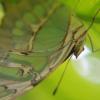I caught her in the escarpment, in the illawarra region, on a drizzly day.
The temperature was about 27* celcius.
This queen is in my D.I.Y semi-claustral queen setup, and has a nice batch of eggs, maybe 10-15.



I will update this journal whenever anything exciting happens.





















